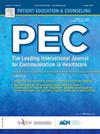生活在美国的中东和北非儿童的病人和以家庭为中心的护理。
IF 3.1
2区 医学
Q2 PUBLIC, ENVIRONMENTAL & OCCUPATIONAL HEALTH
引用次数: 0
摘要
目的:国家对中东和北非(MENA)个人接受的护理质量的估计是未知的。以病人为中心的护理(PCC)的看法是护理质量的重要指标,不同种族/少数民族群体的差异。我们的研究旨在估计父母对以患者和家庭为中心的护理(PFCC)的看法的差异,PFCC是父母对护理质量的感知指标,在外国出生的中东和北非地区和其他种族和族裔群体之间。方法:以Head and Bute对Street生态模型的扩展为理论视角,在联邦统计研究数据中心对2000 - 2017年全国健康访谈调查和2001-2018年医疗支出面板调查数据进行综合分析。样本包括33,677名外国出生的中东和北非儿童的父母,他们报告在过去12个月内访问了医疗保健提供者。因变量包括父母对沟通变量的报告,这些变量与提供者倾听的频率有关;显示尊重;花了足够的时间;并且解释得很好。采用多变量logistic回归,采用PFCC质量和分离域的综合测量来评估接受PFCC的几率。结果:与外国出生的白人(OR=2.49; 95 %CI=1.04-5.97)和亚洲人(OR=2.54; 95 %CI=1.13-5.68)组相比,外国出生的中东和北非儿童的父母报告所有PFCC质量的几率更高。当PFCC质量分开时,与外国出生的西班牙裔相比,外国出生的中东和北非儿童的父母报告他们的提供者花了足够的时间与他们在一起的几率(95 %CI= 1.18-8.81)高出3.23倍。结论:本研究提供了中东和北非地区成人PFCC的首次估计。未来的研究可以设计为测试独特的健康干预措施,并为提供者提供更符合文化的护理提出建议。实践意义:最近,美国政府提出了一项及时的对话,倡导为中东和北非地区人口建立一个单独的种族/民族类别,并得到科学家的认可,以便对所有美国人口的卫生公平进行更严格和准确的评估。本文章由计算机程序翻译,如有差异,请以英文原文为准。
Patient and family-centered care among Middle Eastern and North African children living in the United States
Objectives
National estimates of the quality of care received by Middle Eastern and North African (MENA) individuals are unknown. Perceptions of patient-centered care (PCC) are important indicators of quality of care that differ by racial/ethnic minority groups. Our study aimed to estimate differences in parents’ perceptions of patient- and family-centered care (PFCC), an indicator of quality of care perceived by parents, between foreign-born MENA and other racial and ethnic groups.
Methods
Data from 2000 to 2017 National Health Interview Survey and 2001–2018 Medical Expenditure Panel Survey was combined and analyzed at a federal statistical research data center, using the Head and Bute’s extension of Street’s ecological model as theoretical lens. The sample included 33,677 parents of foreign-born MENA children who reported visiting a health care provider within the past 12 months. Dependent variables included parent reports of communication variables related to how often providers: listened; showed respect; spent enough time; and explained things well. Multivariable logistic regression was used to evaluate the odds of receiving PFCC using a composite measure of PFCC quality and separate domains.
Results
Parents of foreign-born MENA children had higher odds of reporting all PFCC qualities compared to foreign-born White (OR=2.49; 95 %CI=1.04–5.97) and Asian (OR=2.54; 95 %CI=1.13–5.68) groups. When separated by PFCC quality, parents of foreign-born MENA children had 3.23 times higher odds (95 %CI= 1.18–8.81) of reporting that their provider spent enough time with them compared to foreign-born Hispanics.
Conclusions
This study provides the first estimates of PFCC among MENA adults. Future studies can be designed to test unique health interventions and make recommendations for providers to deliver more culturally responsive care.
Practice Implications
Findings add to the timely dialog advocating for a separate racial/ethnic category for MENA populations recently proposed by the US government and acknowledged by scientists for more rigorous and accurate assessments of health equity for all US populations.
求助全文
通过发布文献求助,成功后即可免费获取论文全文。
去求助
来源期刊

Patient Education and Counseling
医学-公共卫生、环境卫生与职业卫生
CiteScore
5.60
自引率
11.40%
发文量
384
审稿时长
46 days
期刊介绍:
Patient Education and Counseling is an interdisciplinary, international journal for patient education and health promotion researchers, managers and clinicians. The journal seeks to explore and elucidate the educational, counseling and communication models in health care. Its aim is to provide a forum for fundamental as well as applied research, and to promote the study of organizational issues involved with the delivery of patient education, counseling, health promotion services and training models in improving communication between providers and patients.
 求助内容:
求助内容: 应助结果提醒方式:
应助结果提醒方式:


